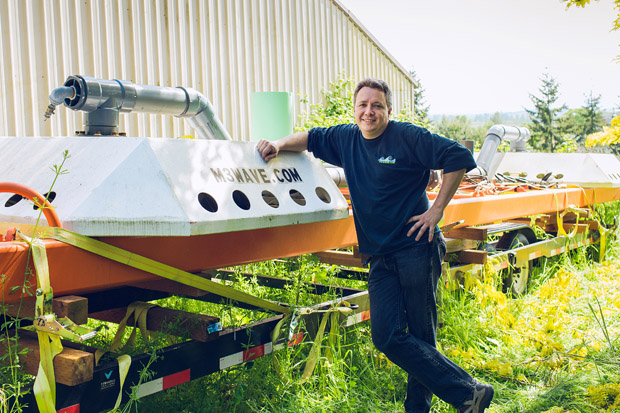BY JACOB PALMER
Mike Morrow and Mike Delos-Reyes first came up with the idea of an ocean power device 23 years ago, when they were students at Oregon State University. They realized a long-held vision last summer, when their startup, M3 Wave, successfully launched the first ocean power device that works underwater.
BY JACOB PALMER
Company: M3 Wave
Founders: Mike Morrow, Mike Delos-Reyes
Launch: 2009
Headquarters: Salem

Sea legs ready: M3 Wave founder Mike Morrow and the Delos-Reyes ocean power device.
Mike Morrow and Mike Delos-Reyes first came up with the idea of an ocean power device 23 years ago, when they were students at Oregon State University. They realized a long-held vision last summer, when their startup, M3 Wave, successfully launched the first ocean power device that works underwater.
Unlike mobile, first-generation wave systems, which harvest energy at the surface, the Delos-Reyes Morrow Pressure (DMP) device stays in one place on the ocean floor. A submerged stationary system is easier to deploy and protects against storms and “rogue waves,” Morrow says.
Figuring out how to harness energy underwater was one challenge. Now comes the harder part: getting funding for advanced research and development. So far the M3 Wave team has relied on federal grants to supplement money from private investors. But national coffers are shrinking, and renewable-energy investors are more interested in time-tested technologies like wind and solar, Morrow says.
“Investors look at wave and say: ‘Those aren’t proven yet, so we’re not going to put the money there.’”
Securing financing in Oregon is especially challenging because the state is rich in cheap power sources like hydropower and wind.
Despite the roadblocks, Morrow is bullish on the applications. He says the military is a natural client because the DMP provides rapid electricity deployment without having to lay down a network.
“It took us three minutes from launching it over the side of the boat to having it start making power,” Morrow says. “That’s with no auxiliary support structure, which is pretty incredible compared to other systems.”
M3 is also targeting islands and other isolated geographical areas as opportunities for quick investment returns. “Alaska is one of those places, where they’re already paying very high prices for electricity,” Morrow says. “So all of a sudden, even an R&D level of cost structure is an appealing business proposition to them.”
The value proposition
One disadvantage of a submerged system is that ocean wave energy is highest near the surface. One advantage is cost-effectiveness. “If the comprehensive [cost of electricity] is superior for a system that harnesses from under the waves, then that provides a compelling business prospect, irrespective of available energy,” Morrow says. “It’s the final cost-per-kilowatt output that matters to consumers and investors.”
Water world
How does the DMP affect the ocean ecosystem? The jury is still out. Morrow says the team “is getting some understanding in the laboratory. Then we’ll go to the stakeholder groups [fishermen, recreational users] and work with them to minimize the impact.”
Click through to read about the efforts in Oregon to harness the power of a volcano.
Hot rocks
While M3 works to harness power off the coast of Oregon, Seattle-based AltaRock Energy is trying to mine energy from the Newberry Volcano south of Bend. The site is one of five under consideration as the hub for a federal field laboratory that produces geothermal energy.
Supported by a $21.5 million U.S. Department of Energy grant, AltaRock has been developing its enhanced geothermal systems technology over the past five years.
Company spokesman David Stowe says a funding deficit is limiting further development of the technology, which creates steam by cycling water down an injection well into the underground heat.
“We’ve had some good tests up there, and we’re only about $2.5 million away [from being fully functional],” Stowe says. More than that remains in the DOE grant, but the agency does not fund drilling. “It’s so ironic,” Stowe laments. “It’s a guy dying of thirst next to a glass of water he’s not allowed to reach.”
Should the Newberry site be selected for the federal laboratory, AltaRock would partner with the Pacific Northwest National Laboratory and Oregon State University on the research. In 2016 the DOE will pick three candidates, which will split $29 million.
“These are unfortunately still science experiments and not commercial products,” Stowe says. “Someone has to invest some money in it, scale it and make it work to get it into the open market.”
- Jacob Palmer is the digital news editor for Oregon Business.
{jcomments on}


